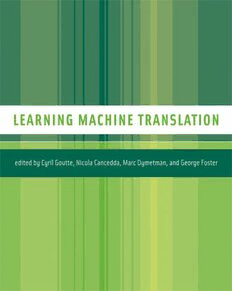
Learning machine translation PDF
329 Pages·2009·4.563 MB·English
Most books are stored in the elastic cloud where traffic is expensive. For this reason, we have a limit on daily download.
Preview Learning machine translation
Description:
The Internet gives us access to a wealth of information in languages we don't understand. The investigation of automated or semi-automated approaches to translation has become a thriving research field with enormous commercial potential. This volume investigates how machine learning techniques can improve statistical machine translation, currently at the forefront of research in the field. The book looks first at enabling technologies—technologies that solve problems that are not machine translation proper but are linked closely to the development of a machine translation system. These include the acquisition of bilingual sentence-aligned data from comparable corpora, automatic construction of multilingual name dictionaries, and word alignment. The book then presents new or improved statistical machine translation techniques, including a discriminative training framework for leveraging syntactic information, the use of semi-supervised and kernel-based learning methods, and the combination of multiple machine translation outputs in order to improve overall translation quality. Contributors : Srinivas Bangalore, Nicola Cancedda, Josep M. Crego, Marc Dymetman, Jakob Elming, George Foster, Jesús Giménez, Cyril Goutte, Nizar Habash, Gholamreza Haffari, Patrick Haffner, Hitoshi Isahara, Stephan Kanthak, Alexandre Klementiev, Gregor Leusch, Pierre Mahé, Lluís Màrquez, Evgeny Matusov, I. Dan Melamed, Ion Muslea, Hermann Ney, Bruno Pouliquen, Dan Roth, Anoop Sarkar, John Shawe-Taylor, Ralf Steinberger, Joseph Turian, Nicola Ueffing, Masao Utiyama, Zhuoran Wang, Benjamin Wellington, Kenji Yamada Neural Information Processing series
See more
The list of books you might like
Most books are stored in the elastic cloud where traffic is expensive. For this reason, we have a limit on daily download.
